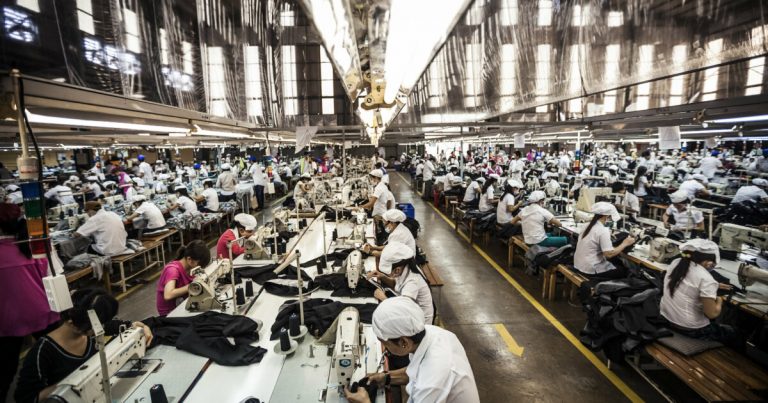Growing public awareness of the climate crisis has put pressure on major retailers to “green” their production chains and make them more sustainable, but much of the work is yet to be completed.
The fashion industry is responsible for up to 10% of global carbon emissions and remains the second largest consumer of water. The culture created by fast fashion, where we refresh our wardrobes to fit this year’s new looks, also produces high levels of water pollution, contaminants and waste that have detrimental effects on the environment and human health.
The past 20 years have seen unprecedented growth in the fashion industry. Today’s consumers buy 60% more clothing than 15 years ago, but clothing waste is also on the rise due to premature disposal, overproduction, and cheap manufacturing. Nearly one-third of all clothing produced is incinerated or discarded before it is sold.
The increased demand created by fast fashion culture is having a devastating effect on global water supplies, with 93 billion cubic metres of this used annually by the fashion industry. Below are the main contributors to water pollution in the textile industry:
Causes of water pollution from the fashion industry
Cotton cultivation
Cotton, the most widely used natural fiber for clothing, requires large amounts of water for irrigation and processing, depleting local freshwater and groundwater resources. To increase the production needed to meet this high demand, pesticides and fertilizers are often used to increase cotton production.
Runoff from pesticide-contaminated water not only damages soil quality and destroys underground microbial communities, but also contaminates nearby water sources, posing a threat to local biodiversity and human health.
Synthetic Fiber Production
Wastewater from the production of synthetic fibers, which requires 70 million barrels of oil per year, releases contaminants such as lead, arsenic and benzene into water sources.
Contaminated wastewater
Textile dyeing and processing operations generate about 20 percent of the world’s wastewater. In Bangladesh alone, garment factories and silk mills use 1.5 trillion litres of water annually, depleting the region’s dwindling groundwater resources and transporting by-products and harmful pollutants to nearby water sources.
Textile finishing and dyeing processes introduce many chemicals into the water, including oils, phenols, dyes, pesticides, and heavy metals like copper, mercury, and chromium. The polluted water then flows into nearby streams and groundwater, where it is then used to irrigate crops, potentially contaminating our food sources with carcinogenic chemicals.
Microfiber Pollution
The contamination of water sources with invisible but highly dangerous microfibers from the textile industry has environmentalists around the world worried, especially because they can spread to rivers and oceans. One study estimates that microfibers account for up to 85 percent of man-made pollution on coastlines, while others warn that 500,000 tonnes of microfibers are dumped into the ocean every year.
These fibers are released not only during the production process, but also once purchased, when clothes are worn and washed. Microfiber pollution from synthetic materials can take hundreds of years to decompose and can disrupt aquatic ecosystems. In fact, traces of microfibers from synthetic materials such as polyester and nylon have been found in fish and other seafood intended for human consumption.
Fashion’s biggest water polluter
The world’s biggest water polluters hide in obscurity because most companies don’t monitor their own contribution to the industry-wide problem, and those that do are reluctant to disclose the information for fear of backlash. A recent survey found that only one in ten fashion companies is aware of their own water pollution levels, and less than a quarter have set targets to reduce water pollution across their supply chains.
In the past, some of the world’s largest retailers, including Zara, Puma, and Armani, have been implicated in China’s water pollution scandals. Companies such as Gap Inc. and H&M have acknowledged their role in water pollution and implemented measures to reduce water usage and pollution throughout their manufacturing processes. It remains to be seen whether these promises are genuine or just greenwashing campaigns to satisfy customers’ environmental sensitivities.
solution
Sustainable cotton cultivation
The World Wildlife Fund has launched the Better Cotton Initiative, which aims to promote sustainable cotton production that minimizes environmental impact. The initiative supports farmers in sustainable water management, reducing pesticide use and promoting decent working conditions.
Shopping at retailers that source their cotton from certified organic cotton suppliers helps promote sustainable agriculture and reduce our impact on the environment.
Choose sustainable materials
To reduce their environmental impact, consumers should choose clothing made from natural fibers such as linen and organic cotton, which require less water in the production process, and where possible, purchase less synthetic fibers that shed microfibers, such as nylon and polyester.
Customers can look for clothing that is certified with restrictions on chemical content, such as OEKO_TEXⓇ and GOTS.
Reducing consumption and production
Fashion is a powerful means of self-expression and the fashion industry is vital to economic growth and development, but current rates of consumption and production cannot continue without worsening dangerous impacts on the environment.
Consumer culture needs to shift towards longer-lasting quality clothing, repairing or donating old clothes, and buying second-hand. On the production side, companies need to move away from expectations of rapid growth and focus on providing timeless, high-quality products.
Image courtesy of ILO/Aaron Santos


